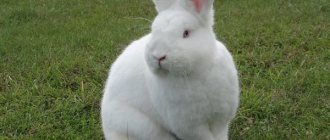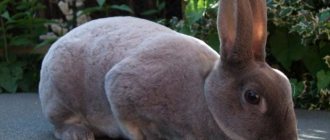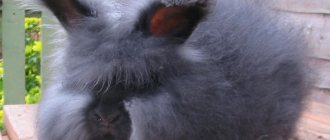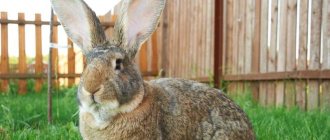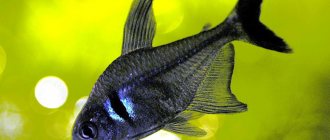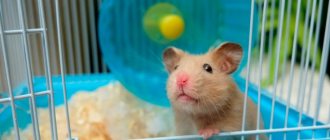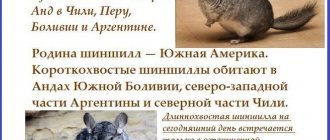The breed group of rabbits “Rex” includes animals that have high-quality, beautiful fur of a very original structure. Most of these animals belong to the category of productive ones, but there are also decorative (dwarf) varieties.
The popularity of Rex rabbits (pictured) in commercial farming is due to the high quality of their skin and fur.
Let's get to know the Rex more closely and start with a brief description in the table of the characteristics of productive representatives of the breed:
| Parameter | Characteristic |
| Animal | Rabbit (Oryctolagus cuniculus L) |
| Breed group | Rex |
| Productive type | Meat skin |
| Live weight of an adult | 4-5 kg |
| Body length | 54 cm |
| Ear length | 11-12 cm |
| Fur color | White, black, bluish, different shades of gray, brown, red, yellow; There are bicolor (spotted) varieties |
| Age of sexual maturity of a female | About 5 months |
| Multiple pregnancy | 4-5 cubs per litter (sometimes up to 7) |
| Deadline for gaining slaughter weight | More than 8 months |
| Killer exit | Up to 60% |
| Quality of skin and fur | Very high |
| Sustainability | For infectious diseases – average; to temperature changes – low (animals suffer greatly from overheating); to humidity – low |
| Registration in the State Register of the Russian Federation | Turned off |
History of origin
If you believe the facts, the breed appeared in France in one of the small villages in 1919. One day, a priest who was breeding Belgian giants discovered a small hairless rabbit in the offspring. Usually animals born with defects are rejected, but the farmer did not do this and kept the baby, consecrating the litter.
Two months later, when the kids grew up, he noticed an unusually beautiful animal, with delicate short fur . The rabbit was named Rex , which means “royal”. Thus, as a result of the mutation of the Belgian giant, a new breed with short, thick fur was obtained.
Already in 1924, the Royal Rex was presented to the general public at an animal exhibition in Paris, where it gained its popularity and wide fame. The velvet-like fur has fascinated many farmers, breeders and manufacturers of expensive fur coats. Since then, large-scale dispersal of animals began throughout Europe and other continents.
The breed was imported into Russia fraudulently from Germany during a time of strict ban on export abroad. The scientist crossed the rex with an ordinary rabbit and got a mixed species, which was imported to Russia . To return varietal qualities, the offspring were crossed with each other and mutated, losing the qualities of an ordinary rabbit.
Feeding
Feeding Rex rabbits is not difficult. Animals do not need special nutrition. In winter, it is recommended to give dry food, tree branches, juicy root vegetables, and a lot of hay. And for the summer, long-eared animals are encouraged to supplement their diet with dried green grass, fresh vegetables, and fruits.
We must remember that long-eared animals should not be given limp, wet, spoiled foods, which can negatively affect their growth and health.
A good feeding option is to use concentrates, where all the necessary nutrients for a specific breed have already been calculated and selected. It is worth noting that rabbits up to 3 months of age are given a lot of alfalfa hay, but older Rexes are given oat hay. Grass and hay are placed in separate feeders (hay bins), separately from other food. Mandatory control over drinking bowls - they should always have clean water available.
Make sure that the hay does not fall out of the feeders! Rex rabbits will never eat off the floor.
Gallery: Rex rabbit (25 photos)
Breed standard
All animals have their own varietal characteristics, by which they differ from other species, and so does the Rex rabbit . The description of the breed is quite simple: its main characteristic is velvety short hair. Consider the breed standard:
- Appearance: body proportional, elongated oval shape. The neck is strong and short. The head is oval, the ears are medium-sized, evenly set. The croup is narrow. The paws are small and thin. The tail is small and fits tightly to the back.
- Weight: an adult can reach a weight of 3 to 5 kg.
- Body length is 40−55 cm.
- The coat is short, does not exceed 2 cm, soft and pleasant, very thick, velvety.
- The whiskers are short and crooked, thanks to this you can immediately distinguish the type of animal.
- The eyes are brown, white colors have reddish and blue shades of eyes.
- The colors vary, about 20 colors are known. Solid colors are allowed: white, black, brown, red, beaver, blue, gray, chocolate, chinchilla, golden. Spotted representatives are encountered. The most popular colors are black and white, but all fur coats look great with velvety fur.
Price
Prices for an ornamental Rex rabbit depend on many factors : pedigree, color and quality of fur, age, expected size of an adult animal, individual assessment of the breeder, etc.
The price for each Rex rabbit is set individually by the breeder.
The most inexpensive ones are rabbits without a pedigree or purebred ones, but with shortcomings.
for purebred representatives is much higher :
- rabbits from producers who have never been exhibited will be cheaper than those from those who have exhibition ratings and titles;
- the higher the breeding score, the more exhibition titles and titles the producers have, the more expensive the baby rabbit;
- prices for rabbits from the same litter can be different, since babies can vary dramatically in “quality”.
Photos of mini rex rabbits
#gallery-1 { margin: auto; } #gallery-1 .gallery-item { float: left; margin-top: 10px; text-align: center; width: 25%; } #gallery-1 img { border: 2px solid #cfcfcf; } #gallery-1 .gallery-caption { margin-left: 0; }
Varieties of Rex rabbits
The Rex breed has several subspecies, the main of which are:
- Rabbit orylag . During the selection of rexes, the orylag rabbit was bred with a more durable and thick coat, which is ideal for sewing fur coats and other fur products. The variety has been bred in France since 1992. Breeding the breed took 15 long years, but the results of the work were rewarded with the desired result. Orilag is characterized by the following colors: chinchilla (gray-white shade), castor (rich brown color with a red tint, it is also called beaver) and “I Gray” (ashy shade of fur).
- Decorative dwarf rex . This subspecies was bred for even shorter fur with a fine, soft texture, and the small animals are very popular as pets. The weight of the babies does not exceed one and a half kilograms, and their appearance is very reminiscent of a plush bunny.
Purchase
Pets should be purchased when their baby teeth are replaced. You cannot buy babies who are less than 30-40 days old. When purchasing, you need to make sure that the type is original.
To do this, you need to pay attention to parameters that are in no way inherent to this type:
- Body weight less than 3 or more than 5.5 kg;
- Various deviations in the constitution of the body;
- Severe pointedness, excessive thinness or drooping of the ears;
- Clumpy, sparse coat with bald patches;
- Ear length more than 13 cm;
- Hair length more than 24 mm;
- The hair on the ears is poorly developed;
- the presence of a double or triple chin.
Performance
Despite high demand, rabbits grow very slowly. By the age of eight months, individuals weigh approximately 3−3.5 kg, monthly weight gain is 200−300 grams.
Plush rodents are raised to produce tender dietary meat that does not have a specific smell and taste, unlike lamb or beef. The skin is highly valued; the fur is used in the production of fur products. Rex fur coats last a long time and do not deform, especially dark colors.
Due to the low number of cubs in the litter and the slow growth of representatives, the cost of the products is high, and the quality is difficult to distinguish from rare and valuable furs.
Diseases and vaccinations
Rexes do not have any special diseases specific to this breed. Like other rabbits, they are susceptible to the following diseases:
- VGBK;
- bloating;
- myxomatosis;
- coccidosis.
Timely vaccination (carried out from 1 month) protects against most diseases. At 2-3 months they are vaccinated against rabies, hemorrhagic fever, and myxomatosis. To reduce the risk of disease, regular veterinary examinations are necessary.
Advice! The breeder should conduct a preventive examination of the fur, ears, teeth and nose of rabbits.
Rex breeding rules
Many farmers choose rabbits as pets for breeding. They do not require expensive feed or extreme conditions for maintenance, but the list of requirements is still long. Violation of the rules can lead to the loss of several individuals or even the entire litter.
Puberty in rabbits occurs at the age of 4-6 months. This can be determined by the behavior of the pet; the female becomes active, aggressive, can suddenly rush towards the cage, fuss, and bite. For mating, a large adult male is selected from another litter, not a relative of the female. If you let it near a blood relative, the offspring will be born weak and defective.
How and what to feed
Rex rabbits are unpretentious in food: they eat grain mixtures, vegetables, and alfalfa. Morning and evening are the peak periods of activity, so constant access to food should be ensured. Feeding at least 3-4 times a day. It is necessary to carefully monitor the presence of clean and fresh water in drinking bowls; during cold periods it should be heated.
The diet is based on concentrates and green food; it is important to add minerals and vitamins. From spring to autumn, Rex rabbits eat mainly green food:
- cereals and legumes (clover, alfalfa, corn);
- wild and meadow herbs - nettle, burdock, dandelion, rhubarb;
- kale;
- father-in-law tops, rutabaga, Jerusalem artichoke.
During the cold season (from autumn to early spring), animals require succulent food with additional fertilizers and mineral supplements. Vegetables are not suitable as the main food - they are a supplement, since most are difficult to digest. It is better to choose raw root vegetables:
- carrot;
- zucchini;
- cabbage;
- potato;
- beet;
- pumpkin (boiled or raw).
Roughage should be included in the diet as a source of fiber. Hay should make up a significant portion of the diet. Rough food includes: legumes and cereal grasses (prepared in advance at the time of flowering or before), branches of pine, spruce, juniper, grain.
Concentrated food is considered the most nutritious - a mixture of grains, bran and cake. It has a high content of organic substances, so it provides a lot of energy. For the base, it is better to choose oats (improves the functioning of the digestive system) and corn.
It is important to monitor the quality of the products: remove dirt, rot, moldy and frozen parts. Dangerous products that can harm the health of rabbits:
- tomato tops;
- wild rosemary;
- buttercup, spurge;
- lily of the valley, fern, dope;
- bird cherry, apricot, elderberry;
- beet tops;
- cherry or sweet cherry branches (due to the content of hydrocyanic acid).
Owner reviews
The pet was purchased at an early age, unknowingly, at 2 months. We fed baby Sonya with special food, plant-based and succulent foods. They gave dry mixtures for the rabbits, hay, grass, cherry branches and apricots, and raw vegetables in small quantities: carrots, cabbage and lettuce.
Sonya is not very sociable, she is shy, she does not like to be picked up, but she loves to be petted while sitting in a cage, where she is apparently more accustomed. Cardboard was used as bedding. My favorite one gnawed and tore everything! Especially at night. While walking around the apartment, she also loved to sin, chewing wallpaper and furniture. I learned to use the toilet quickly and independently, and constantly went to the same place.
Alyona
They gave us a rabbit; we had never had such pets before and had no experience with them.
At first the baby seemed cute and very calm. He ate everything that was given, but upon reaching the age of puberty, he began to behave inappropriately. When they gave him food, he would throw himself on the cage or in your arms, growl, fuss, and shit all over the cage. I had to give it to a familiar breeder who had other pets. Igor
Features of keeping at home
The dwarf Rex rabbit is considered the best decorative breed. Undemanding care and good health are the main points that rabbit breeders highlight from this species. And the key to a long happy life for animals is affection, care and constant communication with eared pets. Moderately active and friendly animals quickly get along in any home and find a common language with all household members.
Home improvement
The recommended cage area for a pet is from 0.28 m2 (the larger and more spacious, the better for the animal). To make a home, you must use galvanized mesh. It is better to choose a removable tray (for ease of maintenance). The litter is changed as it gets dirty, but at least once every 3 days.
The optimal cell size should be 6-7 times larger than the eared ear itself. In addition, the height of the cage should be 2 times higher than the height of the animal standing on its hind legs.
Do not place your home near heating appliances, in a draft or in direct sunlight.
Feeding
The diet of the dwarf Rex includes:
- hay in unlimited quantities (including coarse - for grinding teeth);
- succulent food (vegetables, fruits, dried grass);
- concentrates (grain legumes) – up to 65% of the total volume of feed);
- tree branches;
- granulated feed.
The best types of grasses for daily feeding are timothy and meadow forbs. But rich in proteins, alfalfa and clover are rare, since they cause frequent molting and can cause problems with the excretory system.
Hygiene procedures
The decorative Rex rabbit is a short-haired animal that requires minimal care. But it is still necessary to periodically carry out basic hygiene procedures for your pet:
- combing with a brush or cloth;
- washing the eyes with warm water;
- cleansing the ears with cotton wool soaked in boric alcohol;
- nail trimming.
Rabbit character and taming
By nature, Rexes are fairly calm and balanced animals. They do well in homes with small children or other pets. In the evenings they like to frolic, entertaining others with their funny tricks.
In order for the animals to feel comfortable and not cause trouble, they need to be properly “educated” - trained. The flexible little ears quickly understand the connection between the assigned task and the treat in the hands of the owner, so they can be trained without any problems (they learn to use the tray, respond to a nickname, and perform simple tricks).
When taming, you should remember that animals are very cowardly and should be handled with caution. Raising your voice at pets is strictly prohibited.
Breeding at home
To successfully breed dwarf Rexes, you should remember the following advice from experienced breeders:
- Individuals selected for mating must be kept in quarantine for 2 weeks.
- After lambing, the female must be provided with sufficient water.
- All rabbits are vaccinated without fail according to the established vaccination schedule.
- It is recommended to mate decorative pets from 6 months of age.
There are from 4 to 7 rabbits in one litter. Breeding requires careful care of them. If this is neglected, then not all babies will be able to survive. Although females have a heightened maternal instinct (they can feed both their own and decoy cubs), you need to constantly monitor the nest and its inhabitants. Young animals are removed from their mother at 1.5 months of age - when the ears have completely switched to adult food.
Possible diseases and prevention
Rex dwarfs get sick along with other ornamental relatives, although they have increased body resistance. Among the pathologies there are diseases of both infectious and non-infectious origin.
The most common diseases are:
- VHBK (viral hemorrhagic pathology);
- myxomatosis;
- tympanitis;
- constipation or diarrhea;
- runny nose;
- abscesses;
- diabetes;
- conjunctivitis.
Timely vaccination, periodic examination by a veterinarian, disinfection of cages with equipment, and proper nutrition will help reduce the risk of developing pathologies.
Video Rex Rabbits
